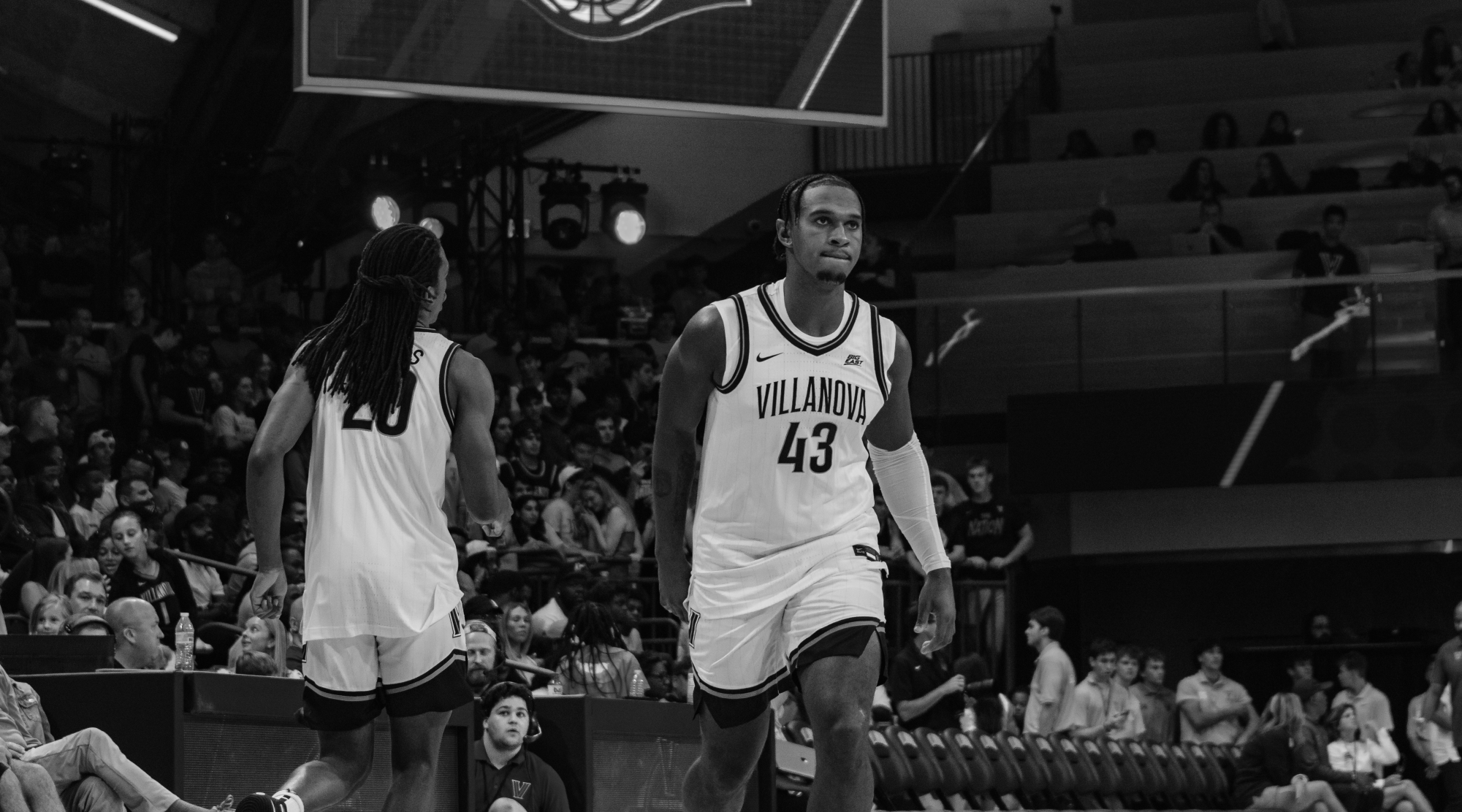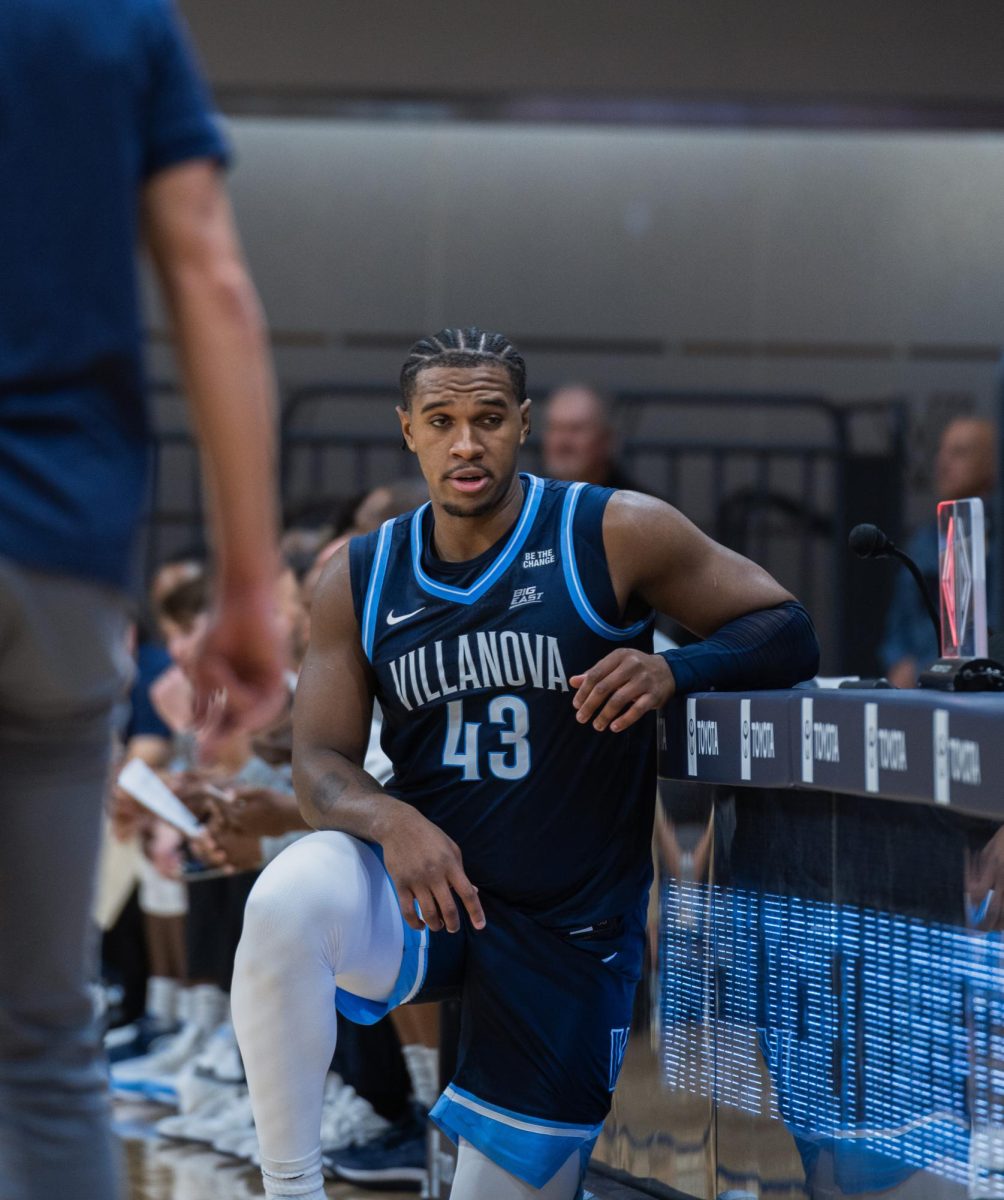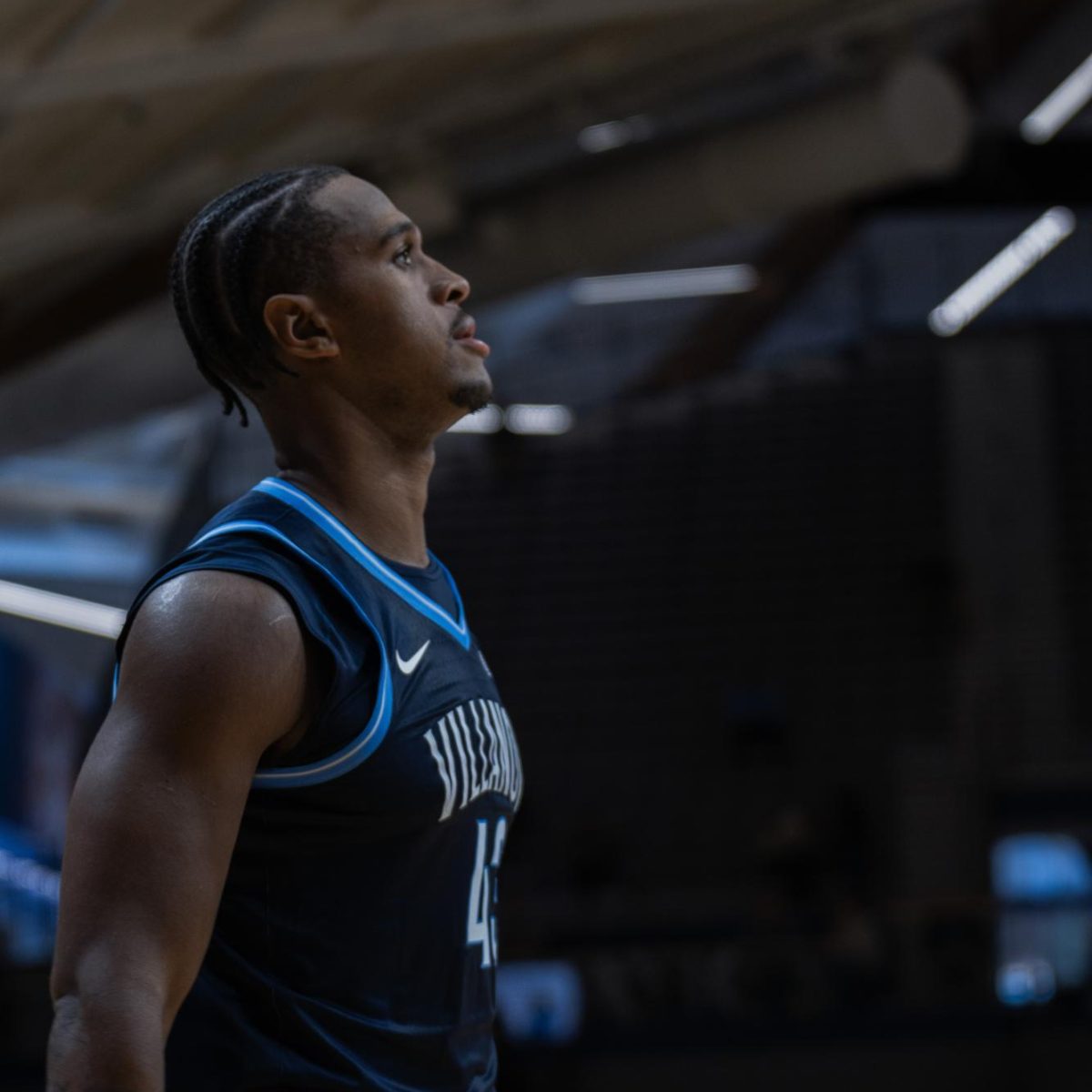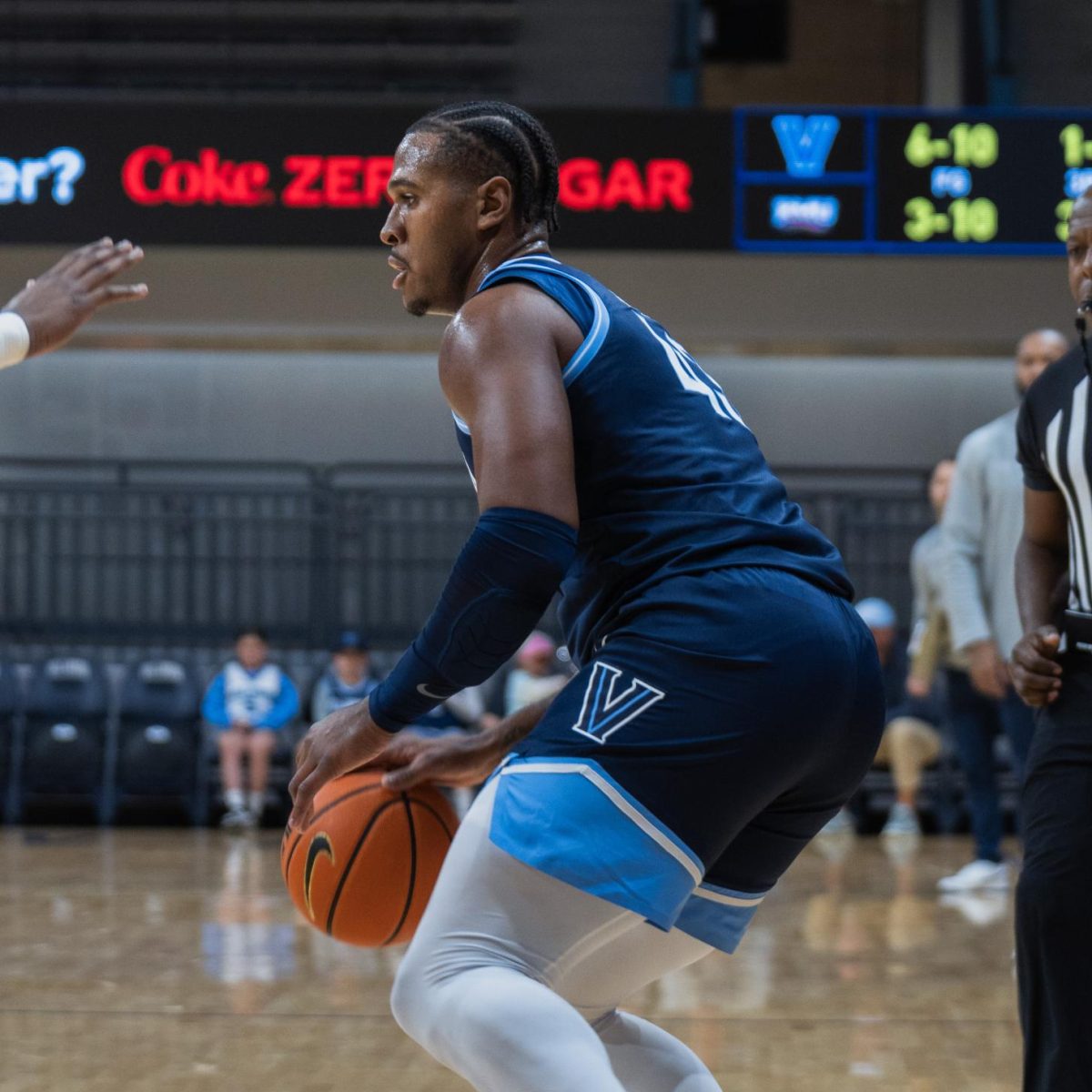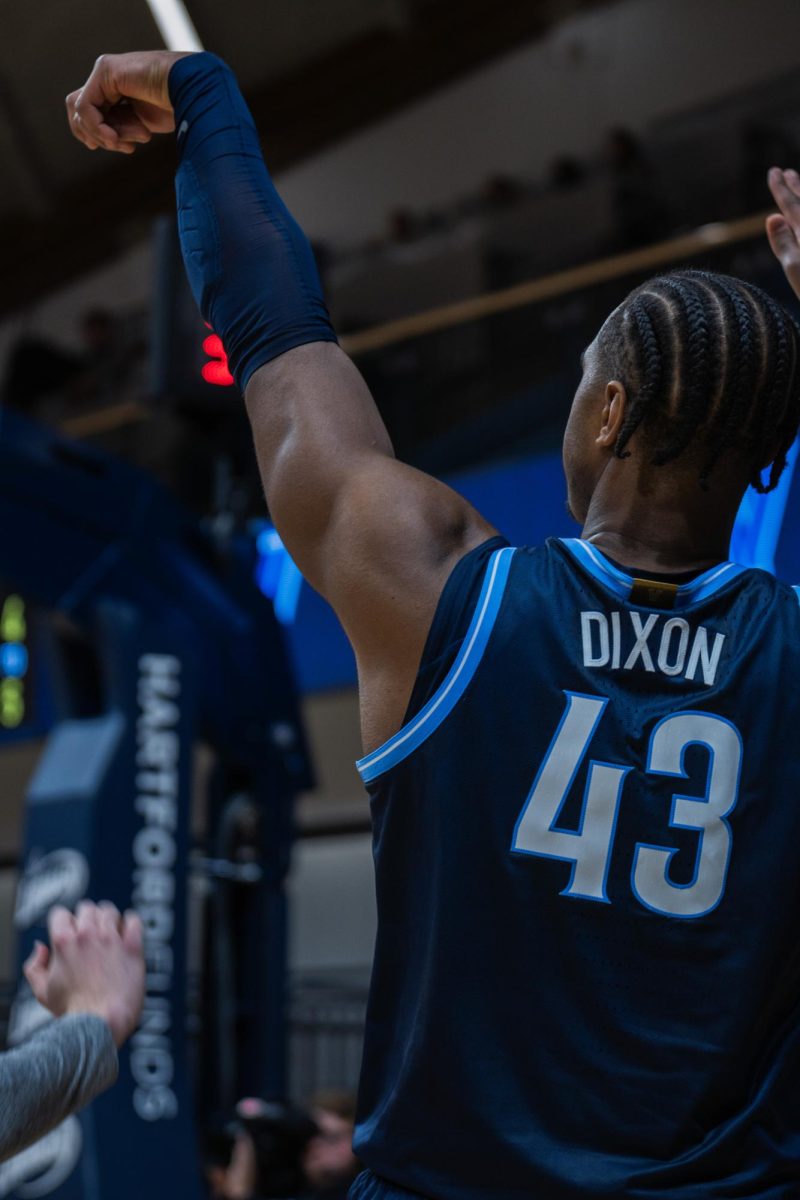1,499 and Counting: Dixon’s Final Season
ERIC DIXON IS DONE AFTER THIS SEASON. For real this time. The now-second year graduate forward tested the possibility of jumping to the NBA after the Wildcats’ 2023-24 season concluded. He’s led the Wildcats in scoring for both of the seasons that head coach Kyle Neptune has been at the helm, and has questioned if he should go pro after both.
“I’ve been saying ‘this is it’ for the last three years,” Dixon deadpans. “When I graduated, and I got my diploma, I was like, ‘I’m out. This is great.’ Then you go through it, and it’s like, ‘alright, maybe not.’ Last year, I was like, ‘I’m definitely done, There’s nothing that can happen.’ Then it’s like, ‘Yeah, you’re going back to school.’ I’m like, ‘Me? School? Can’t see it.’ And here we are.”
This summer’s testing of the pro waters was far more intense, with Dixon declaring for the NBA draft in April. He worked out for multiple NBA teams but ultimately made the call to return to Villanova after it appeared unlikely that he would be able to secure an NBA opportunity.
“The NBA is one of those things that you always dream about as a kid,” Dixon said. “I think now I’m just so close, and it’s more tangible than it feels like it should be, right? It feels like it’s right around the corner, right there at the door.”
Now that Dixon is back, his goal is clear.
“For me to be able to come back and make myself more desirable for guys at the next level by winning games here…” Dixon said. “Because that’s really what it all comes down to. Winning. Winning teams, winning players, that’s all everybody wants. So I think just winning just a little bit more, accomplishing a few more things, and being a better leader can put you right there at the doorstep.”
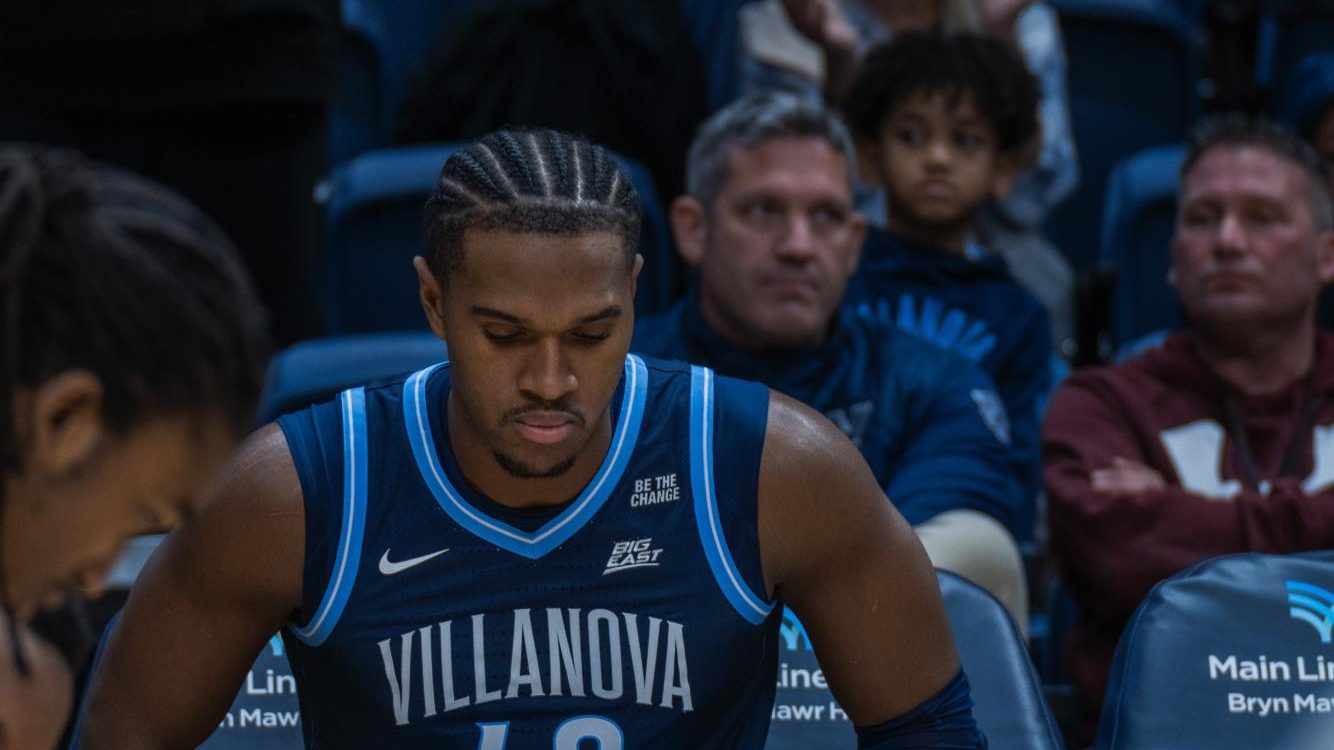
“THAT’S REALLY WHAT IT ALL COMES DOWN TO. WINNING. WINNING TEAMS, WINNING PLAYERS, THAT’S ALL EVERYBODY WANTS.” – ERIC DIXON
AT FIRST APPEARANCE, MUCH HAS CHANGED ABOUT ERIC DIXON SINCE HIS ARRIVAL AT VILLANOVA. His hair, once carefully clipped within a quarter-inch of his skull, has been shaped into neat braids running from the top of his forehead to the back of his neck.
He sports facial hair now. In Dixon’s first five years, his beard progressed from a suggestion to a feature. Now, for his sixth season, Dixon has neatly restricted it to his upper lip and his chin.
Dixon’s status has changed too. The Abington product committed to Villanova 16 days after the Wildcats claimed their third national title in April 2018. Dixon, who was a four-star recruit and the second-ranked prospect in the state of Pennsylvania, redshirted his freshman season.
He emerged as a contributor in 2021-22, his redshirt sophomore season. Dixon started all 38 games for the Wildcats as they made their way to the Final Four in New Orleans, averaging 9.1 points and 6.4 rebounds. In Neptune’s first season, Dixon emerged as the top offensive option. He’s led the team in scoring for the past two seasons, accruing two Second-Team All-Big East selections in that time.
It would be easy to forgive Dixon if he got wrapped up in all this. A lot has changed in the half-decade he’s been in the program. The adjustment from a hall-of-fame coach in Jay Wright to an unproven one in Neptune, going from redshirting to the end of the bench to the starting lineup, the introduction of name, image and likeness policies and the creation of the transfer portal allowing for more freedom of movement for players. Dixon’s been through it all.
Through the coaching transition it faced after Wright retired, Villanova has maintained its core identity. However, it has struggled with remaining a force in the landscape of college basketball. The ‘Cats have lost 33 games over the last two seasons, one more game than the team lost over the final four seasons of Wright’s tenure from 2018-19 to 2021-22.
“We didn’t change any words,” Dixon said. “We didn’t change any posters. Our beliefs are still our core beliefs.”
Villanova was absent from the 2024-25 preseason Associated Press poll, marking the first time since 2013-14 the program was not in the year-opening AP top 25.
The on-court struggles haven’t been for a lack of talent. In Neptune’s first season at the helm, the Wildcats retained 65% of their minutes played and 61.5% of their scoring output from the previous year’s Final Four team. Dixon, guard Justin Moore and forward Brandon Slater, three-fifths of 2021-22’s starting five, all returned for 2022-23. Add on to that the return of key depth pieces and a top-20 incoming freshman class, and it should have been a smooth handoff.
However, the ‘Cats were banged up. Moore, who tore his Achilles in closing moments of the previous season’s Elite Eight win, did not make his return to the court until late January. He only played 13 games in 2022-23, and never returned to his pre-injury form. Forward Cam Whitmore, who was the prize of the ‘Cats’ 2022 recruiting class, missed seven weeks, including the team’s first seven games, after having surgery on his thumb in early October.
After the 2022-23 campaign closed at 17-17, Villanova leveraged its brand and resources and took advantage of the fledgling NCAA transfer portal in hopes to avoid another down season. Neptune and his staff pulled out the fifth-best transfer class in the nation, per 247sports.com. It included forward Tyler Burton, guard TJ Bamba, forward Hakim Hart and forward Lance Ware. Everyone but Ware posted a double figure scoring average the previous season. Only Bamba managed to keep his scoring average above 10, dropping from 15.8 in his junior season at Washington State to 10.1 in his senior season.
A lackluster 18-16 season led to an exodus, with the Wildcats losing eight players to either the NBA draft, exhaustion of eligibility or the transfer portal.
The reality of name, image and likeness policies is that rosters have to be rebuilt on a yearly basis. Many have bemoaned an era of collegiate athletics where it is no longer an option to slowly build up a team’s culture and develop talent. However, the other factor in the NIL equation is that it might enable teams to persuade players looking to make the leap to the pros to come back, especially if that player is projected to go undrafted.
“WE DIDN’T CHANGE ANY WORDS. WE DIDN’T CHANGE ANY POSTERS. OUR BELIEFS ARE STILL OUR CORE BELIEFS.” – ERIC DIXON
DIXON IS THE PRIME EXAMPLE OF THIS. He is currently worth far more to Villanova than he is to any pro squad, which would likely send him to a developmental team.
“It’s just new,” Dixon says, referring to the NIL era. “New is always scary. I’d be lying to say that I was all on board with it right when it came in, but obviously I’m happy, I’m a beneficiary of it.”
In building its roster for this season, Villanova took on a more even balance of freshmen and experienced transfers than in its past two off-seasons. The ‘Cats added four freshmen, including four-star forwards Matthew Hodge and Josiah Moseley, and five transfers to round out its roster. Villanova had one freshman on its roster in 2023-24.
“We haven’t had a young team like this in a long time,” Dixon said. “I haven’t had a chance to lead young guys like this. I haven’t been really excited to watch someone grow the way I’m excited to watch these young guys grow this year.”
Dixon is also familiar with two of the transfers that Villanova brought in this offseason. Guard Wooga Poplar, who is two classes below Dixon, was a force in the Philadelphia Public League before his career at Miami. Dixon and guard Jhamir Brickus, who started his career at La Salle in the fall of 2020, both played for the Philadelphia-area AAU program WE R1.
“[Brickus] played on the team below me, obviously being a year younger,” Dixon said. “We played each other a lot in high school. We played three times in the district playoffs. I won all three times. Put that on the record.”
“NEW IS ALWAYS SCARY. I’D BE LYING TO SAY THAT I WAS ALL ON BOARD WITH IT RIGHT WHEN IT CAME IN, BUT OBVIOUSLY I’M HAPPY, I’M A BENEFICIARY OF IT.” – ERIC DIXON
DESPITE ALL THE VISUAL CUES THAT WOULD TELL THE VIEWING PUBLIC DIXON HAS CHANGED – HAIR, BEARD AND STATURE – HEARING HIM SPEAK IS A SIGNIFIER THAT HIS PERSONAL CORE REMAINS.
He sits in the media room of the Finneran Pavilion at a low table against the wall that is smaller than his six-foot-eight frame would prefer. He extends his leg out toward the center of the room, avoiding contact with the thin leg of the table. Dixon is understated, projecting a gentle confidence. He speaks in a low, muted voice that occasionally pitches up to signify interest or engagement, or something in between.
None of it is a substantive departure from the way Dixon carried himself in the start of his redshirt sophomore season, when he began to emerge as a factor.
Across 127 games over four seasons with the Wildcats, Dixon scored 1,499 points. With his first point of the season, he’ll usurp Moore as the most recent Villanova player to tally 1,500 points over the course of his career.
“Going through the draft process this year, I really thought I was going to be a pro,” Dixon said. “I was like, ‘Dang, 1,499, it’s going to sting.’ Definitely a chance to break that threshold will be nice. You don’t really think about it in the moment, but I know when I look back on it, ten, fifteen years down the line, I’m sure it’ll mean something to me.”
A 1,500-point career isn’t the only milestone left to reach for Dixon. After serving a single-game suspension for participating in the Portsmouth Invitational, a non-certified pre-draft camp he played in during his evaluation process, Dixon needs to appear in 23 games to reach 150 games with the Wildcats.
Forward Jermaine Samuels and Guard Collin Gillespie, two of Dixon’s former teammates, are the only other Wildcats to reach the 150-game mark with the program. If Dixon can play in 30 of the 31 games he is eligible to appear in this season, he’ll pass Gillespie on the program’s all-time games played list, totaling 157.
“It’d be good bragging rights to get a leg up on [Gillespie] on anything,” Dixon said. “It’s a great program, and for me to be able to leave a legacy… I think that was something I always wanted to do wherever I was at. Whether it be with my AAU program, with my high school… I’m just blessed to have the opportunity to do it again at the college level.”
“‘DANG, 1,499, IT’S GOING TO STING.’ DEFINITELY A CHANCE TO BREAK THAT THRESHOLD WILL BE NICE.” – ERIC DIXON
PART OF BUILDING AND LEAVING A LEGACY – ESPECIALLY AT A PLACE WITH A HISTORY BOOK AS THICK AS VILLANOVA’S – IS THE IMPACT YOU MAKE ON OTHERS. Leadership, in the traditional sense, is not a natural aspect of Dixon’s personality. However, it is something that he decided he needed to improve on.
“I never thought I’d be in this position,” Dixon said. “Leadership is one of the things that I always kind of deferred. I’ve always been a guy to just come to the gym, do my job, do what I’m supposed to do, and kind of get out of the way. Being able to grow here as a man, as a person, just seeing the value that being a leader can have. As a young guy, watching [Gillespie] and watching [Saddiq Bey], it gave me a lot of experience. It gave me a lot of ideas, helped me see how they did it.”
Gillespie, the leader of the 2021-22 Final Four team, encouraged Dixon to step up as a leader after he aged out of the program.
“When [Gillespie] was on his way out, he’d be like, ‘E, you’re going to be a leader of this team, you need to step up,’” Dixon said. “I’d be like ‘Ah, I’m good.’ I just kept coming in and worrying about myself, focusing on me, keeping my head down, leading by example. Even last year I struggled with being a vocal leader. Coming into this year, [I’m] just really focusing on making sure I’m there for everybody, and making sure that I’m somebody everyone can look to for whatever they need on or off the court.”
Dixon’s been a redshirt, he’s sat on the end of the bench, he’s been a role starter, a contributor and a top option. He’s also had the benefit of six years of personal growth since his start at Villanova.
“For me, to be able to relate to whoever is in the gym, relate to whatever situation you’re going through, there’s not many things that you’re going to go through that I haven’t gone through,” Dixon said. “Self-doubt, worrying what other people think, I’ve thought about it all.”
The Wildcats have a youthful roster for the first time in a few seasons, with seven underclassmen players. The youth of the team inspired Dixon to reflect on what he wanted to contribute to his teammates in his final season.
“When I got back to campus in June, I looked at the younger guys that we have coming in… I just want to leave them with something in the same way that [Gillespie] and [Daniels] and [Samuels] left me with something,” Dixon said. “I just want them to feel like, ‘E gave me something that I can look back on.’”
As the on-court face of the most embattled stretch the program has faced in a decade, Dixon understands that the onus is on him to lead the team to wins this season. He knows that he won’t be able to do it passively.
“I’ve scored however many points, I’ve got a bunch of rebounds, I’ve got all these accolades, all that kind of stuff,” Dixon said. “The only thing I want to do is win. And I think I understand coming into this last year, I can’t just put my head down and look at myself.”
“THE ONLY THING I WANT TO DO IS WIN. AND I THINK I UNDERSTAND COMING INTO THIS LAST YEAR, I CAN’T JUST PUT MY HEAD DOWN AND LOOK AT MYSELF.” – ERIC DIXON
DIXON IS BACK IN THE MEDIA ROOM, THIS TIME IN A BARSTOOL AT THE TEAM’S PODIUM AFTER DEFEATING ROBERT MORRIS, 87-73, IN AN EXHIBITION MATCHUP. He’s been there many times before. This particular time, he sits stage left of Neptune.
He was far and away the best player on the floor, leading the Wildcats with 28 points. He ran the offense from the perimeter, created his own shot, backed down smaller defenders in the low post, and hit from three all afternoon. In pairing him with 6-foot-11 transfer forward Enoch Boakye, Dixon finds a bit more freedom than he had last season. A lack of size on the 2023-24 roster meant that Dixon was often restricted to the shadow of the stanchion.
“Everyone here has known [Dixon] for a long, long, long, long, long, long time,” Neptune says. It gets a good chuckle out of the smattering of journalists in the media room, and even a smile from Dixon himself.
Outside of that, Dixon is stoic. He and Boakye, who sits stage right of Neptune, field questions from reporters. It’s business. It’s not as business as the next level, Dixon has learned. Pro ball is ruthless.
“I look at Eric Dixon as the most versatile player, possibly, in the country,” Neptune said. “Offensively, there’s nothing that he can’t do. Catch and shoot, post up, he can isolate from the perimeter, finish around the rim, and I think he’s a much-improved passer. Anytime you can fill that many boxes, it makes it tough on the defense.”
Carving out an NBA career remains improbable for Dixon. His offensive versatility and experience are the things he’ll rely on as he gives the pre-draft evaluation process another go after this season. The biggest obstacles remain his size and his age. They’re the two things that he can’t outwork.
NBA teams get 15 full-time roster spots and three two-way contracts that allow them to flex players between the main roster and the team’s NBA G League developmental affiliate. It’s the smallest roster size of the four American major professional sports leagues, with the next-closest being the NHL’s 23-man rosters. With limited spots, NBA teams value production, youth, or in the ideal case, both.
Dixon, who will be 24 before the season’s end, is older than five-year NBA veteran and two-time All-Star Anthony Edwards. Edwards, who left for the Association after one season at Georgia, was selected first overall by the Minnesota Timberwolves before Dixon played a minute for Villanova. A study published at Bryant University found that, on average, NBA players’ production increases until age 32. After that, players generally begin to decline.
If this is to be believed, a team that gives a roster spot to Dixon would get seven or eight seasons of increasing production. Taking a risk on a younger player, a team may be able to find as many as 14 valuable seasons.
The other obstacle for Dixon is that his offensive skill set does not match many NBA offensive schemes. Dixon is best with his back to the basket, but teams don’t frequently work in the low post, instead worrying about perimeter spacing.
His proficiency from three will be a positive in NBA evaluations, but he’ll need to show in his final season that he can do it efficiently in high volume. He shot 48.6% on 35 attempts in 2021-22. In the next two seasons he attempted 100 or more threes, but converted at a clip lower than 40%. In 2023-24, Dixon hit 34.6% of his threes on 159 attempts.
Dixon will have to market his intangible skills, something that has worked for his former teammates. Gillespie, who is viewed as a ‘winning player,’ has spent three years on two-way contracts for the Denver Nuggets and the Phoenix Suns.
Either Dixon makes it, or he doesn’t. It comes down to a balance of opportunity, talent, and a bit of luck. Just as Dixon’s thought for the past three seasons, he’s got nothing to lose.
“I’m going to put everything into this season.” Dixon said. “I want to prepare myself to be the best player I can be. It’s a business at the next level, and it gets very serious, very cutthroat. I come into every single year focused on being ready to handle that kind of business and doing whatever is asked of me.”
Your donation will support the student journalists of The Villanovan with technological needs, training, etc!


